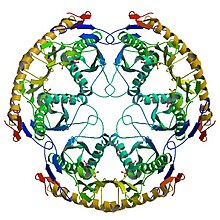| Ribonuclease PH | |
|---|---|
 Structure of the RNase PH hexamer | |
| Identifiers | |
| Symbol | RNASEPH |
| Other data | |
| EC number | 2.7.7.56 |
RNase PH is a tRNA nucleotidyltransferase, present in archaea and bacteria, that is involved in tRNA processing. Contrary to hydrolytic enzymes, it is a phosphorolytic enzyme, meaning that it uses inorganic phosphate as a reactant to cleave nucleotide-nucleotide bonds, releasing diphosphate nucleotides. The active structure of the proteins is a homohexameric complex, consisting of three ribonuclease (RNase) PH dimers.[1] RNase PH has homologues in many other organisms, which are referred to as RNase PH-like proteins. The part of another larger protein with a domain that is very similar to RNase PH is called an RNase PH domain (RPD).
See also[edit]
Two highly related exoribonuclease complexes:
References[edit]
- ^ Ishii R, Nureki O, Yokoyama S (August 2003). "Crystal structure of the tRNA processing enzyme RNase PH from Aquifex aeolicus". The Journal of Biological Chemistry. 278 (34): 32397–404. doi:10.1074/jbc.M300639200. PMID 12746447.
External links[edit]
Well, that’s interesting to know that Psilotum nudum are known as whisk ferns. Psilotum nudum is the commoner species of the two. While the P. flaccidum is a rare species and is found in the tropical islands. Both the species are usually epiphytic in habit and grow upon tree ferns. These species may also be terrestrial and grow in humus or in the crevices of the rocks.
View the detailed Guide of Psilotum nudum: Detailed Study Of Psilotum Nudum (Whisk Fern), Classification, Anatomy, Reproduction